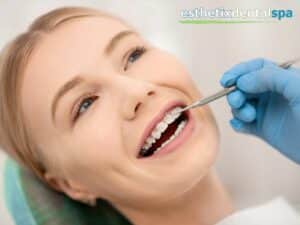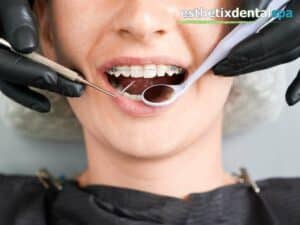Comparing Traditional Metal Braces & Clear Aligners: Advantages & Considerations
When it comes to achieving a straighter, healthier smile, dental braces are one of the most effective solutions available. Whether you’re considering braces for cosmetic reasons or to improve your bite, understanding the different types of braces can help you make the best decision for your oral health needs. From traditional metal braces to clear aligners, each type offers distinct advantages and considerations.
In this article, we’ll explore the various types of braces to help you determine which one is right for you.
Some Dental Braces Options You Should Know About
Here we will show you what types of dental braces there are and the unique characteristics of each type.
Traditional Metal Braces

The biggest advantage of traditional metal braces is their proven effectiveness in correcting a wide range of dental issues, from minor misalignments to more complex cases. Many dentists often recommend these braces for patients with significant bite issues or severe misalignment.
Although highly effective, traditional metal braces can be more noticeable than other types. Some people may feel self-conscious about the appearance of metal braces. However, there are ways to personalize their look, such as choosing colored bands for the brackets.
In addition, newer technologies like heat-activated archwires help reduce discomfort and speed up the alignment process by responding to the body’s temperature.
Ceramic Braces
For individuals who want a more discreet option but still need the reliability of traditional braces, ceramic braces are an excellent choice. Ceramic braces function similarly to metal braces, but the brackets are made of a tooth-colored or clear ceramic material, making them less noticeable.
While ceramic braces are aesthetically more appealing, they come with their own set of considerations. They are typically more expensive than traditional metal braces and may be prone to staining if not properly cared for. It’s important to maintain good oral hygiene to keep the ceramic brackets looking their best. However, they offer a great balance of effectiveness and subtlety, making them a popular choice for many patients.
Lingual Braces
Lingual braces are another option for individuals seeking an invisible solution. Unlike traditional braces, lingual braces are placed on the back of the teeth, making them virtually invisible to others. This type of braces works similarly to metal braces but offers the added benefit of being hidden from view.
One of the major advantages of lingual braces is that they are not visible to others, making them ideal for individuals who are concerned about the appearance of braces. However, lingual braces can be less comfortable than other types because they come into direct contact with the tongue. This may cause irritation, especially in the early stages of treatment.
Additionally, lingual braces tend to take longer to achieve the desired results, and they can be more difficult to clean. Patients must be diligent in maintaining proper oral hygiene to avoid complications.
Invisalign
Invisalign has revolutionized orthodontic treatment, offering a modern alternative to traditional braces. Unlike metal or ceramic braces, Invisalign uses a series of clear plastic aligners to gradually shift the teeth into their correct positions. The aligners are custom-made to fit snugly over your teeth and are virtually invisible, making them one of the most discreet options available.
One of the main benefits of Invisalign is that the aligners can be removed for eating, drinking, brushing, and flossing, giving patients greater flexibility and freedom compared to other types of braces. This is a huge advantage for those who are concerned about the impact of braces on their daily life, as it allows for easier maintenance of oral hygiene and the ability to enjoy a wide variety of foods.
However, Invisalign is generally best suited for individuals with minor to moderate dental issues. If you have more complex orthodontic needs, a more traditional approach may be required. Additionally, Invisalign aligners can be more expensive than other types of braces, and they require discipline to wear them for the recommended amount of time each day.
If you’re considering Invisalign, consulting with a dentist can help you determine if this treatment is the right fit for your dental needs.
Self-Ligating Braces
Self-ligating braces are similar in appearance to traditional metal braces but with one key difference: they use clips instead of elastic bands to hold the archwire in place. This results in less friction and less pressure on the teeth, which can make the treatment process more comfortable for some patients.
These braces offer several advantages over traditional metal braces, including easier cleaning and fewer visits to the dentist for adjustments. The clips used in self-ligating braces allow for faster tooth movement, which can shorten the overall treatment time. However, they are still visible, which may be a consideration for those who want a more discreet option.
Although self-ligating braces are typically more expensive than traditional metal braces, they are an effective choice for patients who want a faster treatment time and improved comfort.
How to Choose The Right Type Of Braces

For individuals with complex dental issues, traditional metal braces may still be the best option. For those who prioritize appearance and want a more discreet treatment, ceramic braces, lingual braces, or Invisalign could be more appropriate.
It’s important to remember that the right treatment for you will depend on your unique needs and goals. Your orthodontist will guide you through the process and determine the best option for achieving your desired results.
Finding The Best Braces For Your Unique Needs
Braces have come a long way in terms of design and technology. With various options available, it’s easier than ever to choose a solution that fits your lifestyle, dental needs, and personal preferences. Whether you opt for traditional metal braces, ceramic braces, lingual braces, or Invisalign, the most important thing is to consult with an experienced dentist who can help you navigate the process and achieve the best results.
If you’re ready to take the next step in your smile journey, contact us at Esthetix Dental Spa today. Our top-rated dental clinic in NY is here to help you explore your options and find the perfect braces solution for you. Schedule a consultation and start your journey toward a confident, beautiful smile!
Esthetix Dentist, NYC’s Dental Implant & Cosmetic Specialist
285 Fort Washington Ave,
New York, NY 10032
Phone: (212) 795-9675
Website: http://esthetixdentalspa.com/

